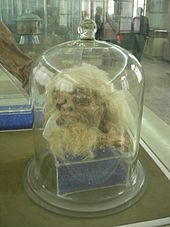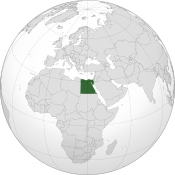Egyptian archaeologists announce discovery of marble statue and 132 new sites
Thursday, May 14, 2009
Zahi Hawass, Egypt's pre-eminent archaeologist, and Secretary General of the The Supreme Council of Antiquities, has announced that a rare statue constructed of white marble whose features resemble Alexander the Great has been discovered in Egypt. Hawass also stated that there are satellite photographs identifying many archeological sites which may also reveal buried monuments.

Calliope Papacosta was leading the Greek archaeological excavation in Alexandria when the white marble statue was found.
"A ribbon around the head of the statue proves that it belongs to an important person for such ribbon was used only be[sic] rulers," said Hawass, "The 80 cm long, 23 cm wide statue has been discovered eight meters deep under the earth surface."

Farouk Hosni, Egypt’s Culture Minister, is supporting archaeological dig sites and has set into place laws restricting illegal digging in confirmed archaeological sites which may contain historical monuments. The monument photography project, National Authority for Remote Sensing, Space Sciences (NARRS) and Mubarak City for Scientific Research (MuCSAT) combined Satellites technology, aerial photography and ground laser to locate 132 sites which have not yet been excavated.
One of these sites is north of Lake Qarun in the Faiyum area, and another at Habu city. Archaeologists are presently being sent out by the Egyptian Ministry of Tourism to areas before construction and building excavations to preserve invaluable archaeological treasures. At the Faiyum site near Cairo artifacts dating to diverse time periods have been found amongst these, an awl for stitching leather, fishing tackle, weapons, jewellery, pottery, coins, sawfish, whale fossils, and a 3150 BC block portraying one of the two leaders named King Scorpion.
Meanwhile, in other archaeological news, Iran's three salt mummies found in the Chehrabad Salt Mine in 1993 will be moved to a technologically advanced vacuum chamber display case in Zanjan for better preservation. These mummies or Salt Men have been dated as being from the Parthian 237 BCE - 224 CE and Sassanid era, 224 - 651 CE.
Related news
- "Egyptian archaeologist finds artifacts which may lead to Cleopatra's tomb" — Wikinews, April 19, 2009
- "30 brightly coloured mummies discovered in Egyptian necropolis" — Wikinews, April 13, 2009
- "Egyptian treasures found in ancient tomb" — Wikinews, March 13, 2009
Sources
- Sahil Nagpal (ANI). "Rare statue of white marble discovered in Alexandria" — TopNews Network, May 12, 2009
- "Egypt State Information Service- Culture - Culture Minister: 132 archaeological sites in Egypt not excavated" — Egypt State Information Service, May 12, 2009
- Zahi Hawass. "Press Release - Archaeological Discoveries in the Faiyum" — Zahi Hawass's blog, May 12, 2009
- "Prehistoric fishing tackle found in Egypt" — AFP, May 12, 2009
- ANI. "Iran’s 4 salt mummies placed in vacuum chamber for preservation" — Sindh Today, May 12, 2009
- "Preservation Techniques for “Salt Men” to Be Upgraded" — CHN, May 11, 2009

